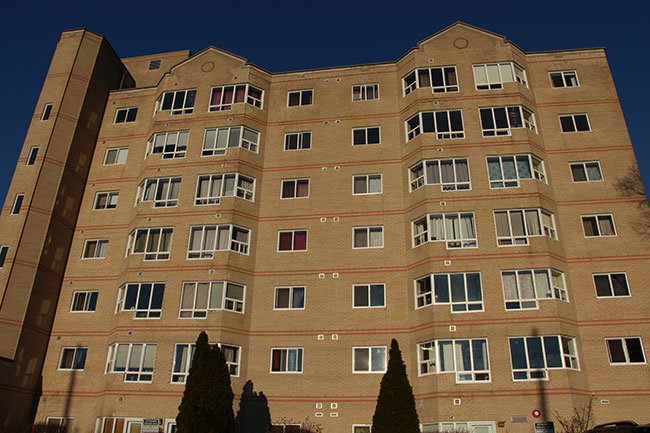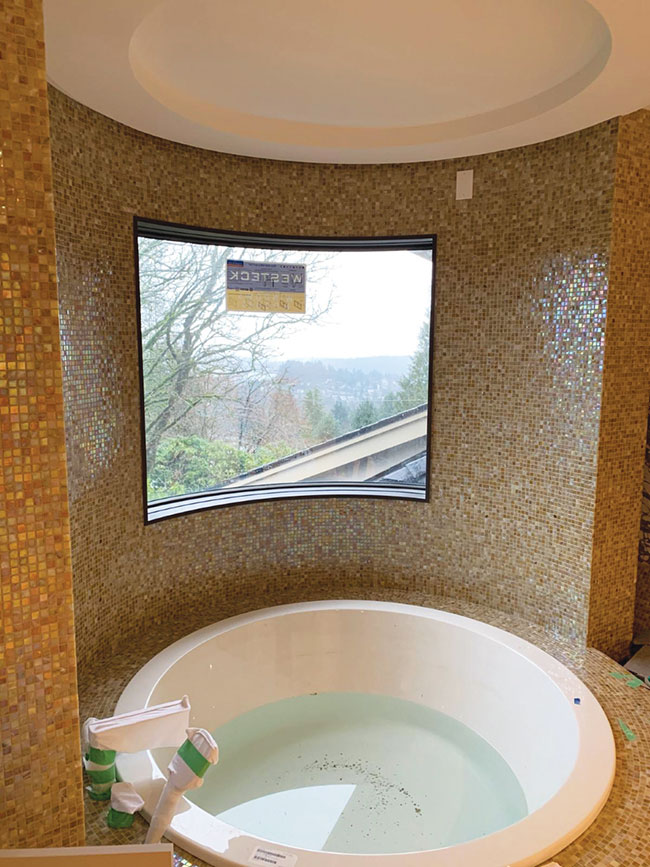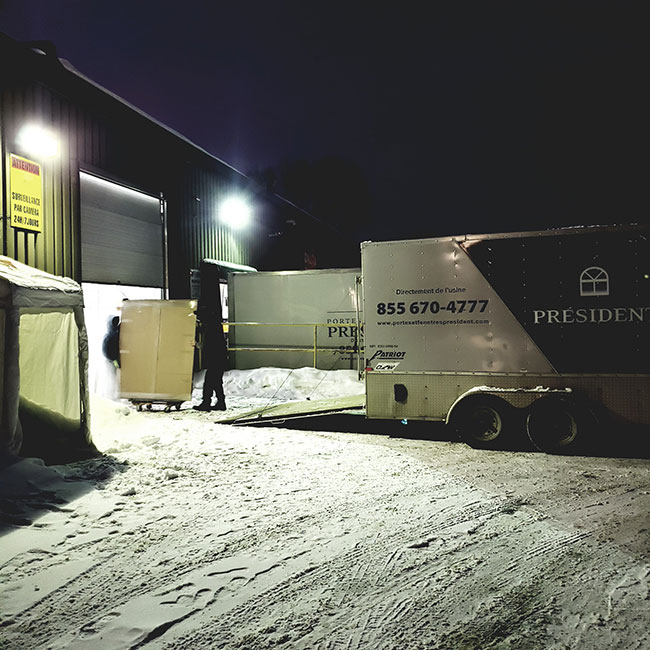
Articles
Dealer’s Corner
Fabrication
Managing Multis – The alternative world of multi-unit residential fenestration
What’s the difference? A lot.
June 3, 2020 By Andrew Snook
 Gearing up to supply multi-unit projects can demand changes to your designs, your installation methods, your shipping and your sales approach. Plus, you’ll have to learn a whole new code language. Photo: Heritage Windows and Doors
Gearing up to supply multi-unit projects can demand changes to your designs, your installation methods, your shipping and your sales approach. Plus, you’ll have to learn a whole new code language. Photo: Heritage Windows and Doors When it comes to supplying single-family homes and multi-unit projects, manufacturers and installers are dealing with two very different beasts.
From project planning and design to quoting, installation, servicing and logistics, there can be many different challenges for installers and manufacturers to take into consideration.
“When doing a single-family home supply, you do the quotes, do the job, ship to site, and you’re basically done,” says Terry Adamson, president of Fenestration Canada and technical director at Westeck Windows & Doors in Chilliwack, B.C.
Adamson’s company focuses on the single-family home market. He says multi-unit projects in B.C. require a great deal more planning, including pages and pages of specifications to review, engaging the services of engineers, field shop drawings, and on-site testing after products are delivered and installed. And to make things even more challenging, it’s a price-driven market.
“It’s a very challenging market to be in,” he says. “If you’re doing spec multi-family – three-, four-, five-storey residential – price is everything. If you have a problem at the end of the job, you’re not making any money.”
Know the code requirements
When it comes to code requirements, there are differences that manufacturers need to consider when suppling windows for single-family homes and buildings up to three storeys (Part 9 of the National Building Code), compared to supplying multi-family units (Parts 3, 4 and 5).
“Most residential window manufacturers are supplying single-family homes – maybe townhouses, maybe small multi-family projects that aren’t too large, up to three storeys – they’re basically selling windows, factory tested, with labels on them. They don’t normally have to get engineers involved in what they’re doing. The energy performance requirements are stated in the code, their products should be labelled with those values, and it’s a fairly simple business compared to doing work on larger, multi-family unit buildings that are designed under parts 3, 4 and 5 of the code,” explains Al Jaugelis, technical director with Fenestration Canada. “At that point, you’re dealing with architects and, depending on whether you’re getting into mid- or high-rise buildings, you’re dealing with higher wind loads. You’re probably going to have to provide shop drawings with those windows. You might need to have an engineer review the drawings and the glass, and how the windows and doors are attached to the building. You may also have enclosure engineers very concerned about how you install those products on that building. You have more professionals looking at what you’re doing and expecting you to know more about how you comply with the code when dealing in the big leagues.”
Quoting considerations
When it comes to the standards testing for products, Jaugelis says there’s no real difference in either market; however, you may be required to submit different types of compliance documentation.
“They might want you to anchor your projects differently. They may want you to use thicker glass, stronger than you’re using in Part 9. When bidding those projects, it’s a little bit of a different ballgame because you’re going to submit to more requirements. The standard things you do in Part 9 and the standard glass you’re using are probably not adequate for those projects,” he says. “You can end up facing unexpected costs to have to upgrade things like glass that you may never have thought you’d have to do, if doing this for the first time.”
Jaugelis says that companies that are used to bidding on jobs for larger multi-unit projects know what to expect, but some companies jumping into the market for the first time get hit with very unexpected and expensive results.
“In much of Canada, it is the expectation that the window supplier has a registered professional engineer – registered in the province that they’re working – that will review their shop drawings and make sure that the right glass strength is there,” he says. “They will look at how your products are anchored and how many screws you need and tell you how to fasten them. You may not be able use your standard anchoring method. The engineer may be obliged by professional responsibilities under Part 4 of the code to deal with things like guard loads on glass and has to upgrade the glass so that the glass is strong enough to handle the specified guard load that would apply to the windows.”
Project teams in charge of these types of larger builds will expect the window and door manufacturers and installers to know these types of things, so companies have to make sure they’re prepared and bid accordingly. Jaugelis suggests that companies cultivate relationships with the engineers in their areas who handle window and door products for these types of buildings.
“Discuss with an engineer the kinds of things you’re going to do, because if you’re going to bid your first job, you better have that engineer approve your glass that you’re planning to include in your quote. You better have the engineer approve what you’re going to do, because you may be seriously underbidding what will be expected,” he says.
Shannon Ruffell of Heritage Renovations based in London, Ont., says that one of the other challenges related to quoting larger projects is that you’re trying to find the best product match based on a group of people instead of a single family.
Benoit Dubord’s company, Portes et Fenetres President in Longueuil, Que., which specializes in the replacement and renovation condo market (up to four storeys), experiences similar challenges. He says the big difference between serving the single-family home market and multi-unit projects is related to ownership.
“The decisions are taken by multiple owners who don’t necessarily have family ties and may have different interests. Some of them are retirees who want to live there for the rest of their lives, and some are younger families who will move within the next two years,” Dubord says. “Some might be focused on immediate cost of replacement and others on maintenance in the future. It’s a challenge because all condos don’t work the same. If you have six owners, you have six involved in the process.”
Installation challenges
When it comes to installing windows, multi-unit projects typically present far more challenges.
“The scale is the major difference,” says Ruffell, who adds that coordinating installation for 100 to 150 window and door replacements across multiple units, tenants and owners can present a variety of challenges when trying to complete a project in a timely fashion. “People are going on vacation, some people are there or not there, some people are owners while others are renting.”
Dubord says the “human aspect” of installations in existing buildings is a major factor to consider.
“You get into people’s homes, living rooms, bedrooms, so people often need to understand how we will manage the work, the schedule, and what we have to do,” he says, adding that you need to have a plan in place to answer those questions when bidding for these types of multi-unit projects.
Dubord adds that new builds tend to offer much simpler installation than renovations and replacements on existing builds.
“The landscaping has not been done; you can use a crane whenever you want to manoeuvre around the building. In the renos that can sometimes be challenging,” he says. “Some places where you’ll have to use a ladder or a product you will assemble on site. You have to have a system for new builds and a system for existing markets, they’re two different beasts.”
Mike Bruno of the Everlast Group of Companies in Etobicoke, Ont., agrees that there is a difference between the two types of installations.
“It’s great to bring in eight-foot by eight-foot sliding doors when under construction, but when the house is completed, it’s a little bit different to manoeuvre in there. Typically you’ll have narrow stairs that are steep, and when you walk up the stairs you hit a wall, which is now going to increase your service fees,” he says. “We’re having a challenge right now on multis where we don’t have elevator access. The entry points are farther from the units with not enough room for installation trucks. Storing windows on site becomes challenging.”
One exception when it comes to single-family homes offering bigger challenges can be in the custom-built market. Adamson’s company focuses on a lot of custom installations for single and smaller multi-family units.
“Five years ago, we were doing a lot more apartment style, multi-units but the margins were so slim we just got out of it,” he says. “We do more Passive House projects: multi-unit projects that are unique and something custom that other spec-type suppliers aren’t prepared to offer.”
Adamson says expectations for these types of installations and future servicing differ a great deal from installation a typical spec window.
“When you’re doing simple windows, they’re less problems,” he says. “Revenue for a single-family [custom] job can be significant, but that can lend itself to challenges after the fact. When you’re spending $150,000 on a window and door package for an upper-end client, expectations are different.”
Logistics
Single-family projects come with simple shipping solutions due to the small amount of product typically being moved. Multi-unit projects are another matter.
“In a lot of cases, we’re having to send out frames on one truck, send out glass on another truck, and have more people unload the product,” Bruno says.
Heritage Renovations recently invested in a new warehouse to accommodate their larger orders.
“We just moved into a new 25,000-square-foot facility, so we’re able to warehouse larger projects,” Ruffell says. “Before we would take in quadrant by quadrant, or floor by floor, but now we can take in more product.”
Marketing
When it comes to marketing your company to the single-family and multi-unit markets, the key is to treat all your clients as potential returning clients, regardless of size, and let them do the marketing for you, according to Ruffell. She says that Heritage Renovations relies a great deal on building on its good reputation and growing through word of mouth, and that her company has been recommended for larger projects by both clients and manufacturers.
“All of our customers we really work with based on them being repeat business, everyone has that potential. We always try and go above and beyond,” Ruffell says.
Print this page

